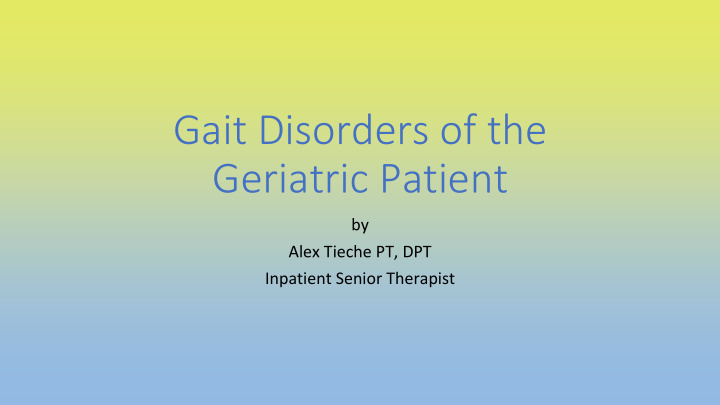



Gait Disorders of the Geriatric Patient by Alex Tieche PT, DPT Inpatient Senior Therapist
Normal Gait Three functional tasks 1. Weight acceptance Weight is loaded onto outstretched limb 2. Single limb stance The body progresses over a single, stable limb 3. Swing limb advancement Limb moves from behind, to in front of, the body
Normal Gait cont. Minimal joint ranges of motion (ROM) at the hip, knee, and ankle are also required to achieve normal gait • The hip requires from 20° extension to 25° flexion • The knee requires 0° extension to 60° flexion • The ankle requires 10° dorsiflexion to 15° plantar flexion
Normal Gait cont. Gait can also be divided into eight phases 1. Initial Contact 2. Loading Response 3. Mid Stance 4. Terminal Stance 5. Pre-Swing 6. Initial Swing 7. Mid Swing 8. Terminal Swing
Normal Gait Speed • Gait speed is normally expressed in meters/second • Average healthy adult gait speed is ~1.4 m/s (3.1 MPH) • Minimum gait speed for community ambulators is 1.2 m/s (2.7 MPH). Why? • Older adults have, on average, a gait speed of 0.9-1.3 m/s (2-2.9 MPH)
• Used to determine gait speed in patients • High intra and inter-rater reliability • Quick and easy to perform Need only a few floor markings and a stopwatch • Can help determine discharge location for an admitted patient • Can be used to determine future mortality of a patient 10m Walk • Help determine effectiveness of a particular therapy treatment Test • Etc…
Geriatric Physiological Changes • IV discs lose moisture, promote kyphotic spine • Osteophytes form in ventral foramen, causing stenosis • Muscles lose contractility and flexibility • OA in hips and knees • Rate of neurological transmission decreases • Decreased vision
Postural/Positional Changes • Increased thoracic kyphosis/forward lean • Parkinson’s • Increased anterior pelvic rotation • Decreased ankle PF in late stance • Decreased arm swing
Effects on Gait • Decreased velocity • Highly indicative of decline in overall health • Slow walkers die on average 6 years sooner than normal speed walkers • Stable until ~70 y/o, then 15% decline/decade • Cadence does not usually change • Increased double stance time • Largely caused by a decrease in plantar flexion strength • What is normal PF strength? • Possible loss of symmetry • Regular (usually muskuloskeletal, painful weight bearing) vs. Irregular (usually neurological i.e. basal ganglia or cerebellar injury) • Painful side experiences increased unsupported time and decreased stance time
Wide based gait • Indicated by measurement of greater than 12” distance from lateral sides of feet • Requires increased weight shift • Usually patients with cerebellar lesion or bilateral hip/knee disease
Circumducting Gait • Leg moves in arc rather than straight line, hip often rotated • Attempt to clear toes during swing phase • Caused by weak pelvic muscles, inability to flex knee
Hip hike/drop, Lateral Trunk Lean • Trendelenburg gait • Weak hip abductors, decreased pelvic girdle strength • Leads to hip drop on contralateral side and/or excessive trunk lean to ipsilateral side • Knee extensor spasticity • Lack of dorsiflexor strength/foot drop from CVA or other neurological injury
• 68 y/o male • Lives with independent but 72 y/o Mr. F spouse in mobile home, 3 STE, no other family near by • Suffered a CVA with resulting L sided UE and LE weakness, UE>LE • Bilateral DF PROM is 0° and L DF strength 1/5 • 3+/5 L knee ext and hip flex strength
• Toe drag on left Gait deficits • Hip hike and excessive hip flexion • Decreased stance time on right • Decreased step length (previous DF ROM limitation)
Interventions • Mobility training begun as early as medically possible • AFO fitted to maintain ankle in neutral dorsiflexion • Use of a hemiwalker on unaffected side initially • Supported gait training to initiate normal gait patterns • Treatments focus on functional tasks relevant to patient’s lifestyle and PLOF (Can I play the piano?)
Interdisciplinary Actions and Discharge • Medical management provided by physician team • OT simultaneously begins ADL training and compensatory practices as needed • Coordinate treatments with nursing staff to maximize pain control and OOB tasks (weighing patients, upright vitals…etc) • Patient and family services reaches out to rehab centered nursing facility and acute rehab centers with ultimate goal of transition back to home after rehab with in home support. Home safety eval may be initiated upon returning home • Home safety features to be implemented in home (grab bars in restroom etc), assistance from APS? Office on Aging? • Patient continues outpatient PT and OT after discharge from rehab with wife present to assist with home exercises, transportation services provided by hospital • Medications must be managed to avoid unwanted effects of polypharmacy
Summary • Maintain or increase gait speed! • Use assistive devices as needed • Use community and hospital resources to maximize rehabilitation • Refer to other disciplines as warranted, remain a patient advocate
Please feel free to contact Priscilla with any questions you may have. Priscilla Bruny Program Coordinator Geriatric Medicine Division P.Bruny@ruhealth.org (951) 486-5623
Recommend
More recommend